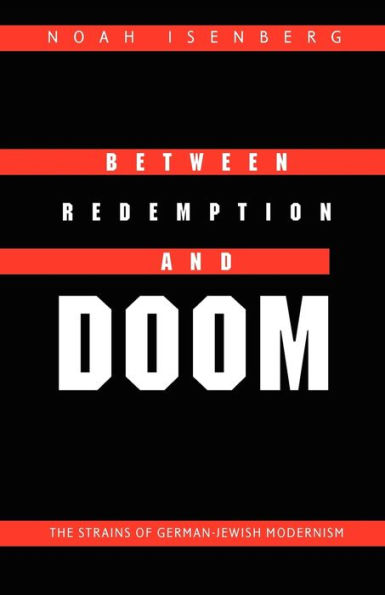Between Redemption and Doom: The Strains of German-Jewish Modernism
Between Redemption and Doom is a revelatory exploration of the evolution of German-Jewish modernism. Through an examination of selected works in literature, theory, and film, Noah Isenberg investigates the ways in which Jewish identity was represented in German culture from the eve of the First World War through the rise of National Socialism. He argues that various responses to modernity-particularly to its social, cultural, and aesthetic currents-converge around the discourse on community: its renaissance, its crisis, and its dissolution.
Isenberg opens with a general discussion of German modernism-its primary forms, movements, and manifestations. Subsequent chapters on Franz Kafka and Arnold Zweig deal with particular instances of the modern, and often ambivalent, search for forms of German-Jewish identity based on cultural and ethnic community. Discussions of Paul Wegener's film Der Golem and Walter Benjamin's childhood memoirs explore the culmination of German modernism and the modes through which Jews were identified in mass society. Throughout, Isenberg shows how Jewish authors and figures confronted the dilemma of self-understanding-the exigencies of community in the modern world-in language, culture, memory, and representation.
Noah Isenberg is an assistant professor of German studies at Wesleyan University.
1112183076
Isenberg opens with a general discussion of German modernism-its primary forms, movements, and manifestations. Subsequent chapters on Franz Kafka and Arnold Zweig deal with particular instances of the modern, and often ambivalent, search for forms of German-Jewish identity based on cultural and ethnic community. Discussions of Paul Wegener's film Der Golem and Walter Benjamin's childhood memoirs explore the culmination of German modernism and the modes through which Jews were identified in mass society. Throughout, Isenberg shows how Jewish authors and figures confronted the dilemma of self-understanding-the exigencies of community in the modern world-in language, culture, memory, and representation.
Noah Isenberg is an assistant professor of German studies at Wesleyan University.
Between Redemption and Doom: The Strains of German-Jewish Modernism
Between Redemption and Doom is a revelatory exploration of the evolution of German-Jewish modernism. Through an examination of selected works in literature, theory, and film, Noah Isenberg investigates the ways in which Jewish identity was represented in German culture from the eve of the First World War through the rise of National Socialism. He argues that various responses to modernity-particularly to its social, cultural, and aesthetic currents-converge around the discourse on community: its renaissance, its crisis, and its dissolution.
Isenberg opens with a general discussion of German modernism-its primary forms, movements, and manifestations. Subsequent chapters on Franz Kafka and Arnold Zweig deal with particular instances of the modern, and often ambivalent, search for forms of German-Jewish identity based on cultural and ethnic community. Discussions of Paul Wegener's film Der Golem and Walter Benjamin's childhood memoirs explore the culmination of German modernism and the modes through which Jews were identified in mass society. Throughout, Isenberg shows how Jewish authors and figures confronted the dilemma of self-understanding-the exigencies of community in the modern world-in language, culture, memory, and representation.
Noah Isenberg is an assistant professor of German studies at Wesleyan University.
Isenberg opens with a general discussion of German modernism-its primary forms, movements, and manifestations. Subsequent chapters on Franz Kafka and Arnold Zweig deal with particular instances of the modern, and often ambivalent, search for forms of German-Jewish identity based on cultural and ethnic community. Discussions of Paul Wegener's film Der Golem and Walter Benjamin's childhood memoirs explore the culmination of German modernism and the modes through which Jews were identified in mass society. Throughout, Isenberg shows how Jewish authors and figures confronted the dilemma of self-understanding-the exigencies of community in the modern world-in language, culture, memory, and representation.
Noah Isenberg is an assistant professor of German studies at Wesleyan University.
19.95
Out Of Stock
5
1

Between Redemption and Doom: The Strains of German-Jewish Modernism
234
Between Redemption and Doom: The Strains of German-Jewish Modernism
234
19.95
Out Of Stock

Product Details
| ISBN-13: | 9780803220638 |
|---|---|
| Publisher: | Nebraska Paperback |
| Publication date: | 12/01/2008 |
| Series: | Texts and Contexts |
| Pages: | 234 |
| Product dimensions: | 5.50(w) x 8.50(h) x 0.70(d) |
About the Author
What People are Saying About This
From the B&N Reads Blog
